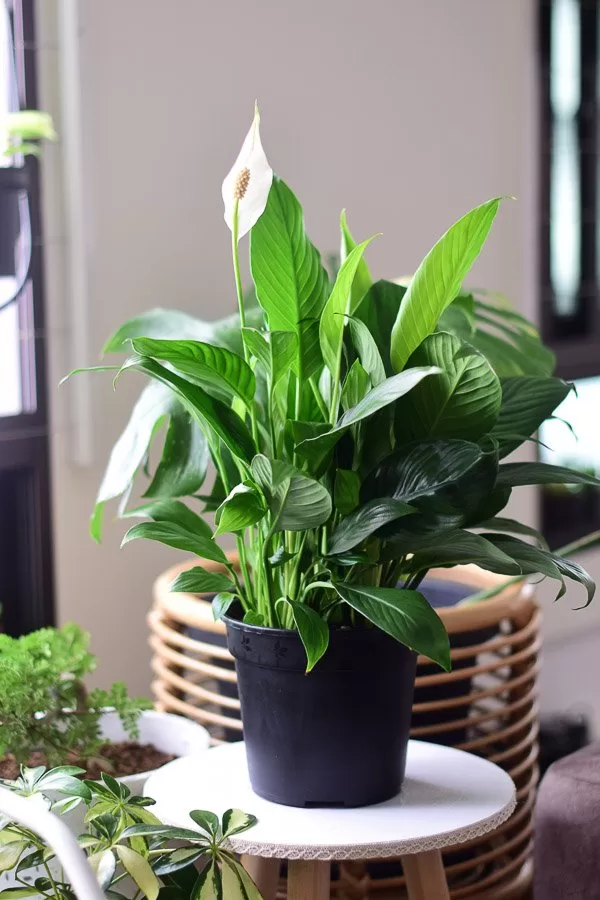To care for a peace lily indoors, follow these steps:
- Place the plant in a spot with indirect, bright light. Avoid direct sunlight as it can cause leaf burn.
- Keep the soil consistently moist, but not waterlogged. Allow the top inch of soil to dry out before watering again.
- Peace lilies prefer a humidity level of around 60-70%, so consider placing a humidifier nearby or placing a tray of water near the plant.
- Fertilize your peace lily every 4-6 weeks with a balanced, water-soluble fertilizer.
- Keep an eye out for pests, such as spider mites and scale insects, and take action if necessary.
- Peace lilies can benefit from regular misting, which can help to increase humidity and wash away dust from the leaves.
- Keep the temperature between 60-85°F and avoid drafts or sudden temperature changes.
- Peace lilies are known to be sensitive to fluoride that is present in tap water. It is best to use distilled or rainwater to avoid leaf spotting.
By following these steps, your peace lily should thrive indoors.
Table of Contents

How often should I water a peace lily?
The frequency at which you should water a peace lily will depend on the specific conditions in your home, such as the humidity and temperature, and how quickly the soil dries out. In general, peace lilies prefer to have consistently moist soil, but not waterlogged. A good rule of thumb is to allow the top inch of soil to dry out before watering again.
It’s a good idea to stick your finger in the soil or use a moisture meter to check the moisture level before watering. Water the plant thoroughly until water runs out of the bottom of the pot and be sure to empty the saucer to prevent the roots from sitting in water.
It is also important to note that peace lilies can be sensitive to fluoride in tap water, which can cause leaf spotting. If you notice this issue, consider using distilled or rainwater to water your peace lily. It’s always better to err on the side of slightly too dry than too wet. Overwatering can lead to root rot and other issues.
Do peace lilies need sun?
Peace lilies (Spathiphyllum) are shade-loving plants and do not need direct sunlight to thrive. In fact, direct sunlight can cause leaf burn and damage the leaves. They prefer indirect, bright light. A spot near an east- or north-facing window is ideal, or you can use artificial light sources such as fluorescent bulbs to supplement natural light.
If you notice that your peace lily is not growing or the leaves are turning yellow, it may be getting too much sunlight. Move it to a spot with less direct sunlight or provide shade with sheer curtains or blinds.
It’s also worth noting that peace lilies that are grown indoors may not be able to photosynthesize as efficiently as those grown outdoors, which can lead to a slower growth rate. However, they can still survive and thrive with the proper care indoors. Keep an eye on the color and shape of the leaves, and adjust the amount of light accordingly. With the right light and care, your peace lily will thrive indoors.
How long does a peace lily last?
Peace lilies (Spathiphyllum) are long-lived plants and, with proper care, can last for several years. The longevity of the plant can be affected by various factors, such as the amount of light and water it receives, the temperature, and the presence of pests or diseases.
In general, peace lilies will grow slowly and will not need repotting often. When they outgrow their pot they will simply produce fewer flowers. They also benefit from regular fertilization and can be divided every 3-5 years to keep them healthy.
It’s worth noting that peace lilies will go through a dormant period, during which they will not produce flowers. This is normal and nothing to worry about. The plant will usually resume flowering once it receives the right amount of light, water and fertilizer. By providing your peace lily with the right care and conditions, you can help it to live a long and healthy life.

Should I cut the brown tips off my peace lily?
It is generally recommended to cut off the brown tips of your peace lily as they can be an indication of a problem, such as underwatering, fluoride or chlorine buildup in the water, low humidity, or exposure to drafty or dry air.
Trimming off the brown tips can help to improve the appearance of the plant and prevent the problem from spreading to other parts of the plant. Use a clean, sharp pair of scissors or pruning shears to trim off the brown tips, being careful not to damage any of the surrounding healthy foliage.
It’s also important to investigate the cause of the brown tips, and make any necessary adjustments to the plant’s care to prevent it from happening again. For example, if the brown tips are caused by chlorine buildup, use distilled or rainwater to water the plant, if it’s caused by low humidity, place a humidifier nearby or place a tray of water near the plant.
Keep in mind that if the brown tips are caused by pests, trimming off the brown tips alone may not be enough to get rid of the problem, and you may need to take additional steps to eliminate the pests.
How do you keep a peace lily happy?
To keep a peace lily (Spathiphyllum) happy, follow these tips:
- Provide bright, indirect light: Peace lilies prefer bright, indirect light, but avoid direct sunlight as it can cause leaf burn. A spot near an east- or north-facing window is ideal.
- Keep the soil consistently moist: Allow the top inch of soil to dry out before watering again. Peace lilies prefer a humidity level of around 60-70%, so consider placing a humidifier nearby or placing a tray of water near the plant.
- Fertilize regularly: Fertilize your peace lily every 4-6 weeks with a balanced, water-soluble fertilizer.
- Watch out for pests: Keep an eye out for pests, such as spider mites and scale insects, and take action if necessary.
- Maintain the right temperature and humidity: Peace lilies prefer temperatures between 60-85°F and a humidity level of around 60-70%. Avoid drafts or sudden temperature changes.
- Avoid fluoride and chlorine: Peace lilies are sensitive to fluoride and chlorine that is present in tap water. Use distilled or rainwater to avoid leaf spotting.
- Keep the leaves clean: Regularly wipe down the leaves with a damp cloth to remove dust and other debris, which can clog the plant’s pores and reduce the amount of light it receives.
- Allow dormancy: Peace lilies will go through a dormant period, during which they will not produce flowers. This is normal and nothing to worry about. The plant will usually resume flowering once it receives the right amount of light, water, and fertilizer.
By following these tips, your peace lily should thrive and be happy. Peace lilies are easy to care plants and they can be a great addition to any indoor space, providing not only greenery but also blooms.
Can you water peace lily with tap water?
It is possible to water peace lilies with tap water, but it is important to be aware that tap water can contain high levels of fluoride and chlorine which can cause leaf spotting and discoloration on the leaves. If you notice these symptoms, it may be best to switch to using distilled or rainwater to water your peace lily.
If you choose to use tap water, it’s best to let the water sit overnight in an open container to allow the chlorine to evaporate before watering your peace lily.
It’s also worth noting that peace lilies prefer to have consistently moist soil, but not waterlogged. Overwatering can cause root rot and other issues. A good rule of thumb is to allow the top inch of soil to dry out before watering again. By being mindful of the water quality and not over watering, your peace lily can thrive even when watered with tap water.

Should I spray water on my peace lily?
Spraying water on your peace lily (Spathiphyllum) can help to increase the humidity around the plant and can help to keep the leaves looking healthy and shiny. This can be especially beneficial if you live in a dry climate or if you have a dry indoor environment.
When you spray your peace lily, use lukewarm water and be sure to spray the leaves and the surrounding air, avoiding getting water on the flowers or in the center of the plant. It’s best to spray your peace lily in the morning or evening when the humidity is naturally higher and the sunlight is less intense.
It’s also important to note that while spraying water can be beneficial, it is not a replacement for watering. Peace lilies still need to be watered regularly to keep the soil consistently moist, but not waterlogged. Overwatering can cause root rot and other issues. A good rule of thumb is to allow the top inch of soil to dry out before watering again.
In addition, you should wipe down the leaves with a damp cloth to remove dust and other debris, which can clog the plant’s pores and reduce the amount of light it receives. This will help the plant to photosynthesize efficiently and increase the humidity. Overall, spraying water on your peace lily can be beneficial, but it should be done in conjunction with proper watering and care.
Where should I place a peace lily in my house?
A peace lily (Spathiphyllum) is a shade-loving plant and prefers bright, indirect light. The ideal spot for a peace lily in your house would be near an east- or north-facing window, where it can receive bright, indirect light without being exposed to direct sunlight. Direct sunlight can cause leaf burn and damage the leaves.
If you don’t have a suitable spot near a window, you can also use artificial light sources such as fluorescent bulbs to supplement natural light. It’s important to monitor the light levels and adjust the placement of the plant as needed to ensure it receives the right amount of light.
It’s also important to consider the temperature and humidity of the room when choosing a location for your peace lily. Peace lilies prefer temperatures between 60-85°F and a humidity level of around 60-70%. Avoid placing your peace lily in a drafty or dry room.
It’s also important to be aware that peace lilies are sensitive to fluoride and chlorine that is present in tap water. If you choose to water your peace lily with tap water, it’s best to let the water sit overnight in an open container to allow the chlorine to evaporate before watering your peace lily. By keeping these factors in mind, you can find the perfect spot in your house for your peace lily to thrive.
How do I get my peace lily to bloom?
Peace lilies (Spathiphyllum) typically bloom in the spring and summer months, but with proper care, you can encourage your peace lily to bloom throughout the year. Here are a few tips to help encourage blooming:
- Provide bright, indirect light: Peace lilies prefer bright, indirect light, but avoid direct sunlight as it can cause leaf burn. A spot near an east- or north-facing window is ideal.
- Keep the soil consistently moist: Allow the top inch of soil to dry out before watering again. Peace lilies prefer a humidity level of around 60-70%.
- Fertilize regularly: Fertilize your peace lily every 4-6 weeks with a balanced, water-soluble fertilizer.
- Provide the right temperature and humidity: Peace lilies prefer temperatures between 60-85°F and a humidity level of around 60-70%. Avoid drafts or sudden temperature changes.
- Avoid over-fertilizing: Over-fertilizing can discourage blooming, as the plant will focus on producing foliage rather than flowers.
- Allow dormancy: Peace lilies will go through a dormant period, during which they will not produce flowers. This is normal and nothing to worry about. The plant will usually resume flowering once it receives the right amount of light, water, and fertilizer.
- Prune dead or yellowing leaves: Remove any dead or yellowing leaves. This will help the plant to redirect its energy towards blooming.
- Keep the plant healthy: A healthy plant is more likely to bloom. Make sure your peace lily is getting the right amount of light, water, and fertilizer.
It’s important to note that blooming is a natural process and can’t be forced. With proper care, your peace lily will bloom.
How hard is it to keep a peace lily alive?
Peace lilies (Spathiphyllum) are relatively easy to care for and can make a great addition to any indoor garden. With proper care, it is not hard to keep a peace lily alive. However, it’s important to understand their specific needs in terms of lighting, watering, and humidity, to ensure they thrive. Here are a few tips to help keep your peace lily healthy:
- Provide bright, indirect light: Peace lilies prefer bright, indirect light, but avoid direct sunlight as it can cause leaf burn. A spot near an east- or north-facing window is ideal.
- Keep the soil consistently moist: Allow the top inch of soil to dry out before watering again. Peace lilies prefer a humidity level of around 60-70%.
- Fertilize regularly: Fertilize your peace lily every 4-6 weeks with a balanced, water-soluble fertilizer.
- Provide the right temperature and humidity: Peace lilies prefer temperatures between 60-85°F and a humidity level of around 60-70%. Avoid drafts or sudden temperature changes.
- Avoid over-fertilizing: Over-fertilizing can discourage blooming, as the plant will focus on producing foliage rather than flowers.
- Allow dormancy: Peace lilies will go through a dormant period, during which they will not produce flowers. This is normal and nothing to worry about. The plant will usually resume flowering once it receives the right amount of light, water, and fertilizer.
- Prune dead or yellowing leaves: Remove any dead or yellowing leaves. This will help the plant to redirect its energy towards blooming.
- Keep the plant healthy: A healthy plant is more likely to bloom. Make sure your peace lily is getting the right amount of light, water, and fertilizer.
By following these tips, you can ensure your peace lily stays healthy and thrives. However, if you are concerned about your peace lily or have issues with its leaves turning yellow, brown or wilting, it’s important to take a closer look at the conditions it’s being kept in and if it’s getting the right care it needs.






